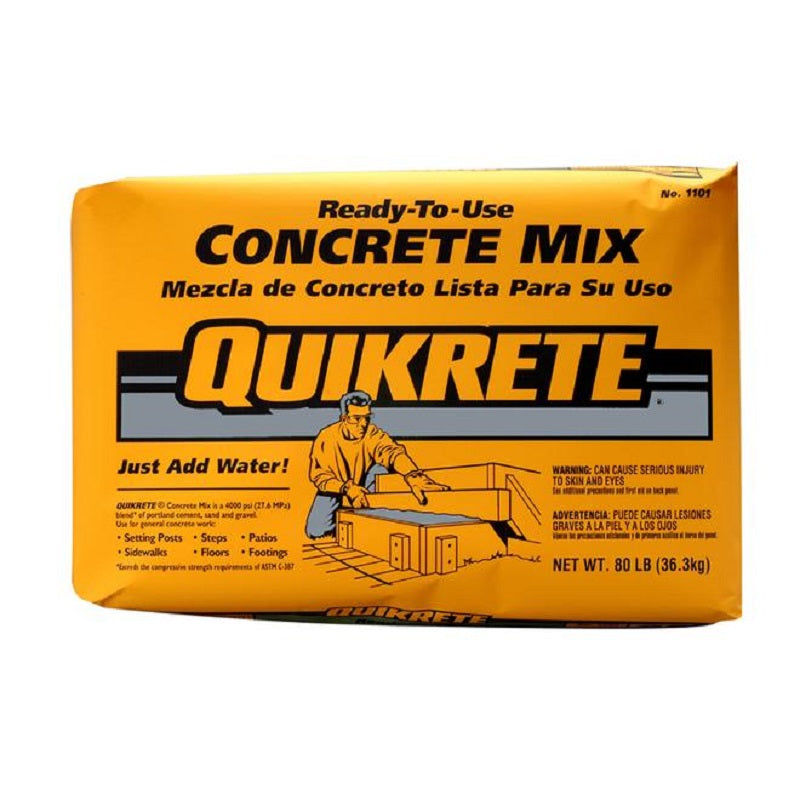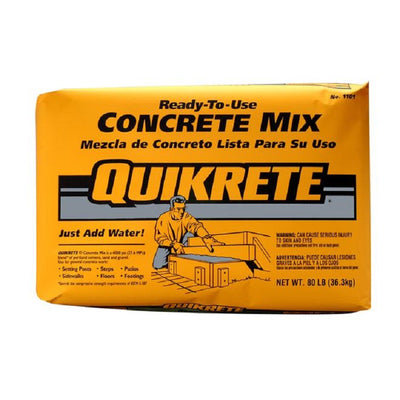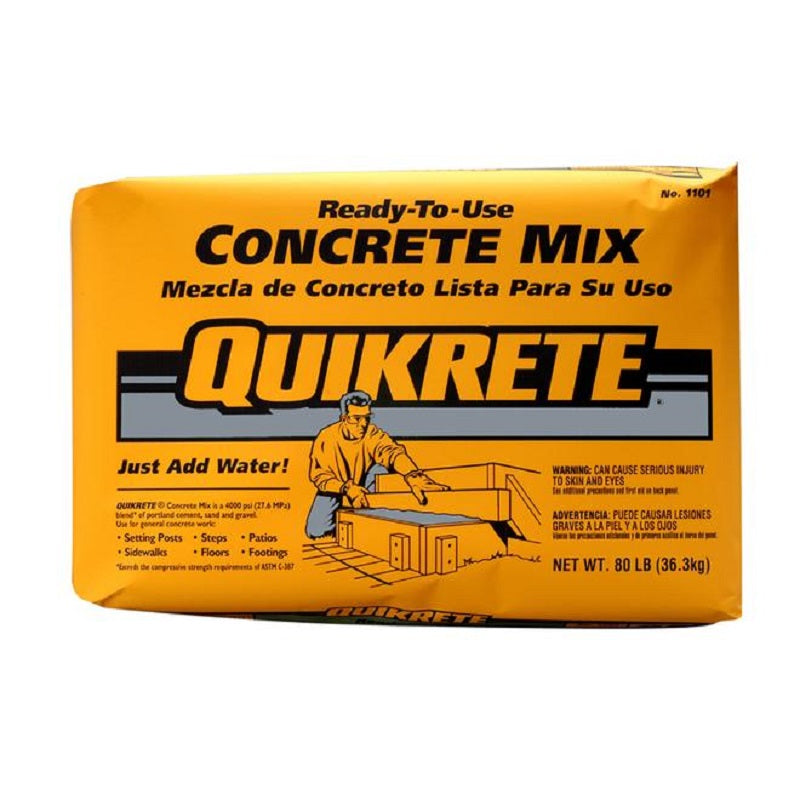Quikrete Ready Mix Concrete 55 Lb.
The number of units will automatically be added to your cart. This product is sold by the unit. The quantity added to the Cart will reflect the square footage of the number of units that are required for your project.
QUIKRETE® Concrete Mix is designed for pouring concrete 50 mm (2") thick or more and building or repairing anything out of concrete, including:
- Foundation walls and footings
- Sidewalks, curbs, steps, ramps and walkways
- Appliance and equipment platforms
- Pipe and post footings
- Floor slabs and patios
- Pools, fish pools, stepping stones
- Splash-blocks and bird baths
- Riprap & slope protection
- Driveway repairs
SIZES
QUIKRETE® Concrete Mix is available in:
- 25 kg (55 lb) bags
YIELD
- A 25 kg (55 lb) bag yields approximately 11.7 L (0.41 cu ft)
TECHNICAL DATA
APPLICABLE STANDARDS
ASTM International - ASTM C387 Standard Specifications for Packaged, Dry, Combined Materials for Mortar and Concrete
PHYSICAL/CHEMICAL PROPERTIES
QUIKRETE® Concrete Mix exceeds the compressive strength requirements of ASTM C387, as shown in Table 1.
TABLE 1 TYPICAL COMPRESSIVE STRENGTH
|
Compressive strength, ASTM C39 |
|
|
Age |
Typical Values |
|
7 days |
17.2 MPa (2500 psi) |
|
28 days |
27.6 MPa (4000 psi) |
|
Slump Range |
· 50-75 mm (2” – 3”) |
Tested under laboratory conditions in accordance with ASTM C387
INSTALLATION
PREPARATORY WORK
Stake out the planned area and remove sod or soil to the desired depth. Nail and stake forms securely in place. Tamp and compact the sub-base until firm.
MACHINE MIXING INSTRUCTIONS
- QUIKRETE® Concrete Mix can be mixed in a barrel type concrete mixer or a mortar mixer.
- Choose the mixer size most appropriate for the size of the job to be done
- Allow at least 28 L (1 cu ft) of mixer capacity for each 30 kg (66 lb) bag of QUIKRETE® Concrete Mix to be mixed at one time
- For each 30 kg (66 lb) bag of QUIKRETE® Concrete Mix to be mixed, add approximately 2.3 L (0.6 US gal) of fresh water to the mixer
- Turn on the mixer and begin adding the concrete to the mixer
- If the material becomes too difficult to mix, add additional water sparingly until a workable mix is obtained
- If a slump cone is available, adjust water to achieve a 50 -75 mm (2" - 3") slump Note - Final water content should be approximately 2.3 – 3.5 L (0.6 – 0.9 US gal) of water per 30 kg (66 lb) bag of concrete. Note – For 25 kg (55 lb) bags, less water is required. See package instructions.
HAND MIXING INSTRUCTIONS
- Empty concrete bags into a suitable mixing container
- For each 30 kg (66 lb) bag of mix, add approximately 2.3 L (0.6 US gal) of clean water
- Work the mix with a shovel, rake or hoe and add water as needed until a stiff, moldable consistency is achieved
- Be sure all material is wet
- Do not leave standing puddles Note – For 25 kg (55 lb) bags, less water is required. See package instructions.
APPLICATION
Method for Pouring a Slab
- Dampen the sub-grade before concrete is placed
- Do not leave standing puddles
- Shovel or place concrete into the form; fill to the full depth of the form
- After concrete has been compacted and spread to completely fill the forms without air pockets, strike off and float immediately
- To strike off, use a straight board (screed), moving the edge back and forth with a saw-like motion to smooth the surface
- Use a darby or bull float to float the surface; this levels any ridges and fills voids left by the straight edge
- Cut the concrete away from the forms by running an edging tool or trowel along the forms to compact the slab edges
- Cut 25 mm (1") deep control joints into the slab every 1.8 - 2.4 m (6' - 8') using a grooving tool. Allow concrete to stiffen slightly, waiting until all water has evaporated from the surface before troweling or applying a broom finish
Note - For best results, do not overwork the material.
Method for Setting Fence Posts
- Dig post hole about 3 times the diameter of the post. Hole depth should be 1/3 the overall post height
- Place 150 mm (6") of dry concrete mix in the bottom of the hole. Position the post, checking that it is level and plumb. Combine
- concrete mix with water and place into the hole
- When standing water has evaporated from the concrete, smooth the surface. Taper it away from the post so rain will flow in that direction. Wait 24 hours before post is subjected to any strain
- For load-bearing applications, follow local building codes for proper footing specifications
FINISHING
Any standard concrete finishing technique is acceptable for use with QUIKRETE® Concrete Mix. Concrete can be hand troweled, powertroweled, broom finished or finished with other specialty finishes.
CURING
General
Curing is one of the most important steps in concrete construction. Proper curing increases the strength and durability of concrete, and a poor curing job can ruin an otherwise well-done project. Proper water content and temperature are essential for good curing. In near freezing temperatures the hydration process slows considerably. When weather is too hot, dry or windy, water is lost by evaporation from the concrete, and hydration stops, resulting in finishing difficulties and cracks. The ideal circumstances for curing are ample moisture and moderate temperature and wind conditions. Curing should be started as soon as possible and should continue for a period of 5 days in warm weather at 21°C (70°F) or higher or 7 days in colder weather at 10 - 21°C (50 - 70°F).
Specific Curing Methods
- QUIKRETE® Acrylic Cure & Seal – Satin Finish provides the easiest and most convenient method of curing. Apply by spray, brush or roller soon after the final finishing operation when the surface is hard. The surface may be damp, but not wet, when applying curing compound. Complete coverage is essential
- Other methods of providing proper curing include covering the surface with wet burlap; keeping the surface wet with a lawn sprinkler and sealing the concrete surface with plastic sheeting or waterproof paper to prevent moisture loss
- If burlap is used, it should be free of chemicals that could weaken or discolor the concrete. New burlap should be washed before use. Place it when the concrete is hard enough to withstand surface damage and sprinkle it periodically to keep the concrete surface continuously moist
- Water curing with lawn sprinklers, nozzles or soaking hoses must be continuous to prevent interruption of the curing process
- Curing with plastic sheets is convenient. They must be laid flat, thoroughly sealed at joints and anchored carefully along edges
PRECAUTIONS
- Curing compounds should not be applied if rain or temperatures below 10°C (50oF) are expected within 24 hours
- Curing with plastic or burlap can cause patchy discoloration in colored concrete. For colored concrete, wet curing or the use of QUIKRETE® Acrylic Cure & Seal – Satin Finish is recommended
- Do not use curing compounds during late fall on surfaces where deicers will be used to melt ice and snow. Using curing compounds at that time may prevent proper air drying of the concrete, which is necessary to enhance its resistance to damage caused by de-icers
- Protect concrete from freezing during the first 48 hours. Plastic sheeting and insulation blankets should be used if temperatures are expected to fall below 0°C (32°F).
DATA SHEET DOWNLOADS



